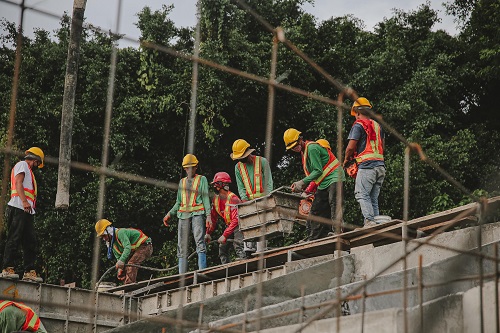If you are a general contractor running or working on a large construction project or the property owner overseeing a large project, getting a wrap-up liability insurance policy can adequately address your liability risks and put your mind at ease.
That’s because a wrap-up liability policy is more efficient and ensures everyone working on a project is protected by one policy versus having to check every subcontractor or other contractor involved to ensure they have their own coverage.
They are called ‘wrap-up’ insurance policies because they cover multiple parties by bundling several policies into one.

Wrap Up Liability Insurance Coverage Basics
Wrap-up liability insurance is designed to protect general contractors, subcontractors, and others such as owners, engineers, and architects working on large construction projects with an all-encompassing policy covering their third-party and general liability exposures.
Related Posts
Sign Up for ZenMail
"*" indicates required fields
Contractor-Controlled Insurance or Owner-Controlled Insurance?
There are two kinds of wrap-up liability insurance policies: a contractor-controlled policy and an owner-controlled policy.
Contractor-controlled wrap-up liability insurance is purchased by the general contractor leading the project, and it extends protection to all contractors and subcontractors hired to work on the project. Similarly, an owner-controlled wrap-up liability policy covers all the contractors involved in a construction project, but it is bought by the owner of the property.
One more wrinkle to iron out: the property owner and the general contractor can jointly purchase a wrap-up policy, making it a partner-controlled insurance policy. The difference is the sponsors of a partner-controlled policy share the protection and benefits.
What Are the Benefits of a Wrap-Up Liability Insurance Policy?
There are a few benefits to you and your team in purchasing a wrap-up liability policy, including:
- A single wrap-up liability policy removes the risk of coverage gaps or insufficient coverage limits across multiple policies. In other words, it’s better, more effective coverage for all.
- Wrap-up liability insurance provides a simplified claims management process, streamlining any claims submitted to your insurance provider.
- Because a wrap-up policy involves bundling multiple coverages together, there are usually premium savings to be had.
- Typically, higher coverage limits are available for all contractors listed on the policy.
- General contractors don’t need to fret about monitoring all their subcontractors’ certificates of insurance.
What Does an Owner-Controlled Wrap-Up Policy Cover?
An owner-controlled wrap-up insurance policy typically includes:
- Commercial general liability (CGL) insurance
- Workers’ compensation
- Builder’s risk insurance
- Professional liability insurance
- Umbrella commercial insurance
Optional additional coverage can be included, such as pollution liability insurance. However, there are other types of insurance that are not included in an owner-controlled wrap-up policy, like commercial auto insurance.
What Does a Contractor-Controlled Wrap-Up Policy Cover?
Like an owner-controlled wrap-up liability policy, a contractor-controlled policy usually provides the same type of protection.
However, a general contractor may prefer a contractor-controlled policy because it may cost less than an owner-controlled policy and offer higher coverage limits, particularly if the contractor has a good relationship with their insurance provider and a favourable claims history. In turn, the property owner reaps the benefit of the lower premium and higher coverage limits.
Moreover, if the general contractor owns the policy, the property owner is more inclined to stay the course and not hire a different contractor to take over the existing construction project.
What Is the Difference Between a Wrap-Up Policy and Builder’s Risk Insurance?
A builder’s risk insurance policy (sometimes called course of construction insurance) is a must-have for contractors, but it cannot provide the same amount of protection as a more fulsome wrap-up policy.
Builder’s risk insurance covers the property under construction and the tools and equipment at the job site. It does not include commercial general liability (CGL) protection. However, CGL can be added to a builder’s risk policy. Additionally, as it is included in a wrap-up liability policy, if yours is a large, complex construction project, a standalone builder’s risk policy may be insufficient to cover your risks.
How to Get Wrap-Up Liability Insurance
Regardless of the type of wrap-up liability coverage you require for your construction project, getting the protection you and your team need is quick and easy with Zensurance.
Fill out an online application to get a free quote. Our licensed brokers can answer your questions and help you manage your risk to ensure your project has the solid foundation it needs.
Recent Posts
Why November Is the Perfect Time for Bookkeepers to Review Their Insurance
As we inch toward the end of another year, bookkeepers are busy preparing for the end of their clients’ financial year. But now is the ideal time for bookkeepers to review and assess their insurance. We’ll give you 10 reasons why.
Is Your Salon Ready for the Holidays? Insurance Tips for Beauticians
Salon owners and independent beauticians need to stock up on the products they need to make their clients shine over the holidays. But ensuring they're adequately covered with customized insurance is also critical. Here's what to know.
10 Tips for Closing Your Small Business for the Winter
Are you closing up shop for the winter? Ensuring your property is prepared for winter and your valuable contents and inventory are safely stored is vital. See our tips for how small business owners can shut down operations and keep their assets safe.








